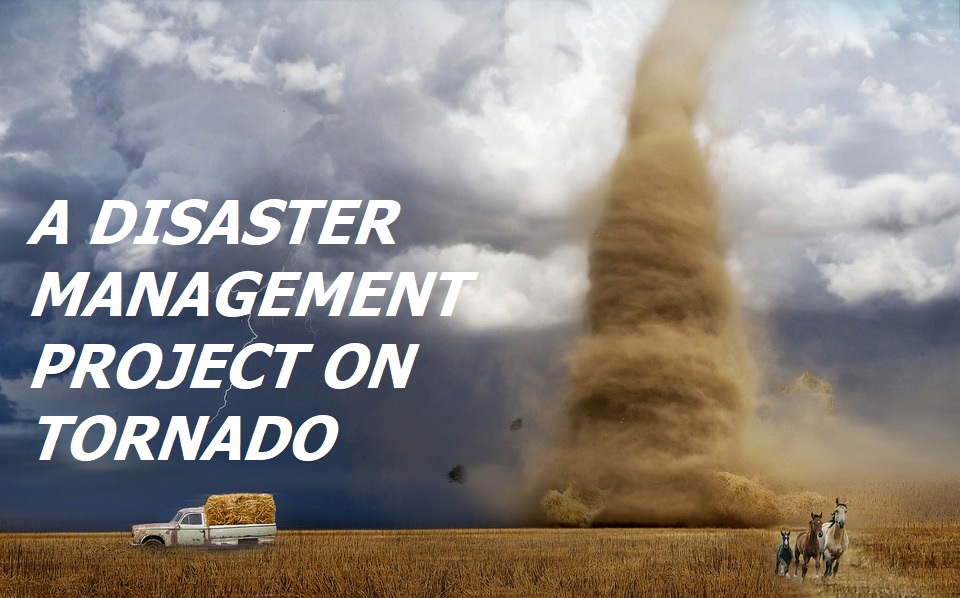Tornado In USA and Canada: A Disaster Management Project
Tornado in USA and Canada is quite natural. But, writing a disaster management project on tornados in USA and Canada can be a complex task as it requires research and analysis of various aspects of the topic. However, If you are looking for a disaster management project on tornados in USA and Canada, this blog article is going to help you out. You will get complete guidance here as per the CBSE norms. With every topic, do not forget to add or draw attractive images. Also, check out 15 Quick Tips On Russia Ukraine Conflict 2022 – A Complete Project Guide For School Students
Here are some general steps that can be followed to write such a project:
First Page – Cover page Of Project “Tornado In USA and Canada”

DISASTER MANAGEMENT PROJECT ON TORNADO IN USA AND CANADA
The cover page of your project creates the first impression.
Therefore, do a lot of research work, surf the internet, get ideas, and then design a unique cover page.
See that your cover page reflects the topic.
At the top of the page write the name of your project in bold letters.
Do not forget to mention your Name, Class, and Sec, Roll No.
Use waste materials like broken bangles, ice-cream sticks, used match
sticks, wool, etc. to design the cover page.
Make an attractive border.
Avoid using plastic covers.
PRAIRIES GRASSLAND ECOSYSTEM – The Climate and Geography that make this region so distinctive.
Second Page – Index (Project On “Tornado In USA and Canada”)
Content or the index page to mention the topics along with the page numbers.
Use a sketch pen for drawing the lines.
You may also use a contrasting color for writing the Topic.
if you are using red color for drawing lines, use Blue/Green color for writing the topic and Page No.
Write the topics in the content with the Blue/Black ink that you are using to write the project.
Third Page – Acknowledgement (School Project on “Tornado In USA and Canada”)
Every project must include an acknowledgment.
On this page, you have to mention the name of your school, your Principal, and your subject teacher.
Keep it short and write in good handwriting.
ACKNOWLEDGEMENT (Example)
I would like to express my special thanks of gratitude to my Principal ___________________ and my Geography teacher _____________for giving me this golden opportunity to complete the Disaster Management Project on the topic “Tornado In USA and Canada”, which helped me a lot in enhancing my wisdom while doing the research and during the course of completion of this project.
This project would not have been completed without their enormous help, Guidance, and support.
I would also like to thank my parents, relatives, and friends for providing me with all the facility that was required.
Whenever I was in need, they were always there behind me.
Although the project has been prepared with utmost care and deep routed interest, even then I accept respondents and imperfections.
Date: Name: XYZ
13/05/2021 Class & Sec IX – A
10-Page Project On Turkey Earthquake: Do You Really Need It? This Will Help You Decide
Fourth Page: Introduction
Begin with an introduction to tornadoes and their impact on USA and Canada.
A tornado is a violently rotating column of air that extends from the base of a thunderstorm cloud to the ground.
Tornadoes can have wind speeds that range from 65 mph to over 200 mph, and their paths can be up to several miles long and hundreds
of yards wide.
Tornadoes are formed when warm, moist air at the surface is forced upwards by cooler, drier air, creating an updraft.
If there are strong horizontal winds that change direction and speed with height, this can cause the updraft to rotate, forming a rotating
column of air.
If the rotating column of air becomes narrow and strong enough, a tornado can form.
Tornadoes can occur anywhere in the world.
But they are most common in the United States.
Particularly in a region known as Tornado Alley, which includes parts of Texas, Oklahoma, Kansas, and Nebraska.
In Canada, tornadoes are most common in the Prairie provinces and southern Ontario, but they can occur in any part of the country.
Tornadoes can be extremely dangerous and destructive.
It can cause injuries, fatalities, and significant damage to buildings, infrastructure, and the environment.
Historical Analysis
Provide a historical analysis of tornadoes in Canada, detailing significant events, their impact, and how they were managed.
Tornadoes are a common occurrence in the United States and Canada, with both countries experiencing hundreds of tornadoes every year.
Historical analysis of tornadoes in these two countries reveals some interesting trends and patterns.
In the United States, tornadoes occur most frequently in the central and southern states, often referred to as Tornado Alley.
These states include Texas, Oklahoma, Kansas, and Nebraska, among others.
The most active month for tornadoes in the US in May, although tornadoes can occur at any time of the year.
According to the National Oceanic and Atmospheric Administration (NOAA), the US experienced an average of 1,253 tornadoes per year
between 1991 and 2020.
The deadliest tornado on record in the US occurred in 1925 in Missouri, Illinois, and Indiana, killing 695 people.
In Canada, tornadoes are most common in the southern and central provinces, including Ontario, Quebec, and Saskatchewan.
The most active month for tornadoes in Canada is June, although they can occur from April to October.
According to Environment Canada, an average of 80 tornadoes occur in Canada each year, with most of them being relatively weak.
However, Canada has also experienced some significant tornado outbreaks in the past.
For example, in 1985 Barrie tornado killed 12 people, and the 1996 Pine Lake tornado killed 27 people.
In recent years, both the US and Canada have seen an increase in tornado activity.
This increase has been attributed to factors such as climate change and changes in land use patterns.
As a result, it’s more important than ever for people in tornado-prone areas to be prepared and take appropriate safety measures when
tornadoes occur.

DISASTER MANAGEMENT PROJECT ON TORNADO IN USA AND CANADA
Risk Assessment:
Conduct a risk assessment of tornadoes in Canada, including the areas that are most susceptible, and the frequency and intensity of tornadoes in those areas.
Risk assessment is an important process in preparing for a tornado.
It involves evaluating potential hazards and identifying measures to minimize risks and prevent damage.
Here are some steps to consider when conducting a risk assessment for a tornado:
Identify potential hazards
Identify the types of hazards that could occur in the event of a tornado, such as high winds, flying debris, flooding, and power outages.
Evaluate the likelihood of occurrence
Determine the likelihood of a tornado occurring in your area based on historical data and weather forecasts.
Assess the potential impact
Assess the potential impact of a tornado on your property, including damage to buildings, infrastructure, and equipment.
Identify vulnerable areas
Identify areas that are most vulnerable to tornado damage, such as windows, doors, and roofs.
Develop a mitigation plan
Develop a plan to mitigate risks and reduce potential damage, such as installing storm shutters or reinforcing doors and windows.
Plan for emergency response
Develop an emergency response plan that includes evacuation procedures, communication strategies, and provisions for essential supplies
and equipment.
Train personnel
Train employees or household members on tornado safety procedures, including identifying safe areas and evacuation routes.
Regularly review and update the plan
Regularly review and update your risk assessment and emergency response plan to ensure they remain effective and relevant.
By conducting a thorough risk assessment and implementing appropriate measures, you can minimize the potential impact of a tornado and
increase the safety of yourself and others.
Emergency Preparedness
Discuss emergency preparedness measures that have been taken in Canada, including warning systems and evacuation procedures.
Preparing for a tornado before it happens is crucial to ensure the safety of yourself and those around you. Here are some preparedness steps
that you can take:
Stay informed
Be aware of weather conditions in your area and listen to local news and weather reports for updates and alerts about severe weather.
Have an emergency kit
Prepare an emergency kit with essential items such as water, non-perishable food, a first aid kit, flashlights, batteries, and a battery-powered
or hand-crank radio.
Identify a safe shelter
Identify a safe place to take shelter during a tornado, such as a basement, storm cellar, or interior room on the lowest level of a building.
Avoid areas with windows or exterior walls.
Practice evacuation plans
Develop and practice evacuation plans for your family or household, including designated meeting places and routes to safety.
Secure your property
Secure outdoor objects such as lawn furniture, trash cans, and garden tools, as these can become dangerous projectiles in high winds.
Have a communication plan
Establish a communication plan with family, friends, and neighbors to stay connected during and after the tornado.
Keep important documents safe
Keep important documents such as identification, insurance policies, and other important records in a secure and accessible location.
By taking these preparedness steps, you can be better equipped to protect yourself and your loved ones in the event of a tornado.
It is important to review and update your preparedness plans regularly to ensure they are current and effective
Disaster Response
Discuss disaster response plans that have been put in place in the event of a tornado, including coordination between emergency services and various levels of government.
Tornadoes are violent and destructive storms that can cause serious damage to life and property.
If you live in an area prone to tornadoes, it’s important to be prepared and know what safety measures to take in case of a tornado.
Here are some safety measures to consider:
Be alert
Stay informed about the weather conditions in your area by checking weather forecasts and listening to local news and emergency alerts.
Have a plan
Make a plan with your family or household members about where to take shelter during a tornado.
Identify safe areas in your home or community that are away from windows, doors, and outside walls.
Prepare an emergency kit
Keep an emergency kit handy that includes a first-aid kit, water, non-perishable food, flashlights, batteries, and a battery-operated radio.
Secure your home
Ensure that your home is secure and protected by closing all windows and doors, and securing any outdoor furniture or equipment that
could become dangerous projectiles in high winds.
Stay indoors
If a tornado warning is issued for your area, stay indoors and take shelter in a safe area of your home or community. Do not go outside to try
to spot the tornado.
Use a helmet
If possible, wear a helmet to protect your head and brain in case of flying debris.
Stay informed
Keep listening to the radio or television for updates and information about the tornado and any related dangers.
Remember, tornadoes can be very unpredictable and dangerous, so it’s essential to take these safety measures seriously and act quickly to
protect yourself and your family.

Post-Disaster Recovery
Discuss post-disaster recovery efforts and measures taken to assist affected communities in the aftermath of a tornado.
After a tornado has passed, it’s important to take certain precautions and follow specific steps to stay safe and begin the recovery process.
Here are some things to do after a tornado:
Stay tuned for updates
Continue to listen to the radio or television for updates on the storm and any related dangers.
Check for injuries
Check yourself and others for injuries. If someone is injured, seek medical attention immediately.
Check for gas leaks
If you smell gas, leave the area immediately and contact your gas company or emergency services.
Check for structural damage
Check your home or building for any structural damage that could be dangerous.
If you see any cracks, sagging, or other signs of damage, contact a professional to assess the situation.
Turn off utilities
If you suspect that there is damage to gas, water, or electrical lines, turn off the appropriate utilities at the main switch or valve.
Avoid damaged areas
Stay away from damaged buildings and areas with downed power lines or debris. Watch out for broken glass and other hazards.
Document damage
Take pictures or videos of any damage to your property, as this will be helpful for insurance purposes.
Contact insurance company
Contact your insurance company to report any damage and begin the claims process.
Begin cleanup
Begin cleaning up debris and removing any hazardous materials. Be sure to wear protective clothing and follow proper safety procedures.
Remember, the aftermath of a tornado can be dangerous.
Therefore, it’s important to take these steps carefully and follow all safety guidelines to ensure your own safety and the safety of others.
Conclusion
Conclude the project by summarizing the main findings and highlighting the importance of ongoing disaster management efforts to mitigate the impact of tornadoes on Canadian communities. Understanding the characteristics of tornadoes in the USA and Canada, and taking appropriate safety measures can help minimize the impact of these storms and increase the safety of individuals in tornado-prone areas. In writing about a disaster management Project on tornadoes in USA and Canada, it’s important to mention an emergency plan that includes identifying safe areas and evacuation routes. Conducting a risk assessment and developing a mitigation plan can also help reduce potential damage and increase safety.
Overall, tornadoes in USA and Canada are a reminder of the power of nature and the importance of being prepared for unexpected weather events. By taking appropriate safety measures and staying informed about weather conditions, individuals can reduce the impact of tornadoes and protect themselves and their communities.
You may be interested in the most popular projects:
Project On Women’s Empowerment: Analyzing Women’s Participation and Representation in Politics
Gender Inequality in India: A Curse On Mankind





0 Comments